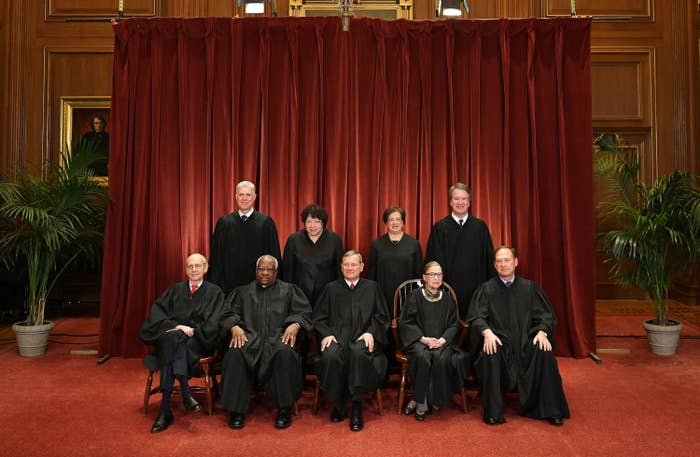
WASHINGTON — The death of Justice Ruth Bader Ginsburg leaves the US Supreme Court with eight justices heading into the fall, setting the stage for possible tie votes from the nation’s highest court during the most litigious election cycle in recent history.
In one sense it’s a repeat of 2016, when the death of Justice Antonin Scalia in February 2016 — and Senate Majority Leader Mitch McConnell’s decision to block then-president Barack Obama’s nominee — meant the court only had eight justices during an election year.
But with the Nov. 3 election just seven weeks away, the legal landscape is dramatically different than it was four years ago. Voting rights groups and the Democratic Party are racing to court to expand mail-in voting during the coronavirus pandemic while President Donald Trump and the Republican Party are waging a multimillion-dollar, multistate effort against it. To date, there are more than 300 election-related cases pending in state and federal courts, according to litigation tracking sites.
And beyond any legal fights over how Americans can vote during a deadly pandemic leading up to November, there’s the specter of another Bush v. Gore situation — an inconclusive election, with results delayed by an overwhelming number of mail-in ballots, followed by weeks of fighting over ballot counts and furious litigation by lawyers for Trump and Joe Biden that winds up before the Supreme Court. Trump and Biden are reportedly amassing teams of hundreds of lawyers and preparing to spend millions of dollars to fight in court over the election.
In a July interview with Fox News Sunday, Trump was asked if he would accept the results of the election if he lost. “I have to see,” he replied.
Election-related cases are most likely to reach the Supreme Court in the coming weeks as emergency applications, where the losing party in a case asks the justices to immediately pause a ruling — known as a “stay” — while an appeal moves forward. Each justice is assigned to handle emergency applications from each of the country’s 13 circuit courts. Under normal circumstances, they rule on those requests alone.
But a justice can refer an emergency application to the full court to decide, which typically happens in high-profile or especially contentious cases. When that happens, it takes a majority of the justices to vote to grant a stay and stop a lower court ruling from going into effect.
If there’s a 4–4 decision in Ginsburg’s absence, the request is denied. That would leave whatever lower court ruling was at issue in place.
Following Ginsburg’s death, there are now three justices that make up the court’s more liberal wing — Justices Stephen Breyer, Sonia Sotomayor, and Elena Kagan — and five justices on the court’s more conservative arm — Chief Justice John Roberts Jr. and Justices Clarence Thomas, Samuel Alito Jr., Neil Gorsuch, and Brett Kavanaugh.
The justices do not always vote along those lines, however. Roberts in particular has earned the ire of Trump for siding with the court’s more liberal justices in several high-profile cases against the administration. But Roberts has tended to stick with his fellow Republican appointees when it comes to voting rights issues.
The Supreme Court has already acted on several stay requests related to how states handle voting during the pandemic. As the Washington Post reported in late July, the court’s more conservative justices so far have largely joined together to rule in favor of state limits on mail-in voting and other in-person election activities. Ginsburg, along with some members of the court’s liberal arm, voted in favor of leaving in place court orders that allowed more flexible election practices.
Stephen Vladeck, a professor at the University of Texas School of Law and Supreme Court litigator, told BuzzFeed News that when there are vacancies, the Supreme Court in the past has tried to avoid ties, which mean that no nationwide precedent is set for lower courts to follow.
“In both of the recent instances where the court was down a justice, we saw all of the justices work very, very hard to minimize division, to build consensus, and to find ways of avoiding 4–4 splits wherever possible,” he said. “What we’re left to hope is that if an election-related crisis does reach the court, the same pattern repeats itself.”
There are other, longer-term implications of an eight-justice court. The next Supreme Court term begins in October, and there are already several blockbuster cases scheduled for arguments. On Nov. 10, the court will hear the next big fight over the future of the Affordable Care Act. On Dec. 2, it will hear arguments in House Democrats’ fight with the Justice Department over access to still-secret grand jury materials from former special counsel Robert Mueller’s investigation.
The court can hear arguments and decide cases with only eight justices. But Vladeck said that when it appears the court is going to tie, especially in a high-profile case, they historically have held off issuing a decision until a ninth justice is confirmed and then rescheduled another round of arguments; the court usually doesn’t offer any explanation when it puts a case back on the calendar.
If the justices decide to delay rulings in cases argued this fall until a nominee is confirmed for Ginsburg’s seat, it means a decision might not come until well into 2021.

